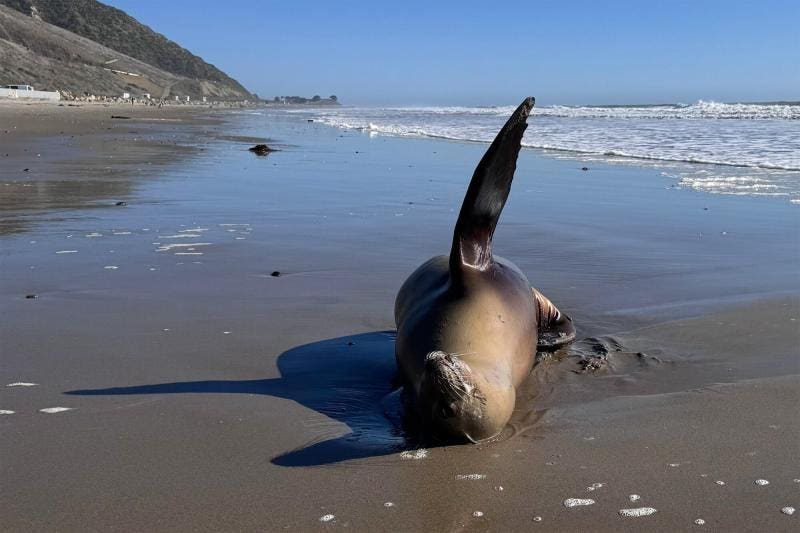Alfred Hitchcock’s 1963 film The Birds is believed to be inspired by real events. In 1961, along the shores of North Monterey Bay, California, “crazed seabirds pelted the shores;” these sooty shearwaters started flying into objects, dying on the streets, regurgitating anchovies. This odd, disconcerting event was worthy fodder for a horror film. Analysis shows these birds had ingested high amounts of domoic acid, from a diatom called pseudo-nitzschia, the same chemical that’s poisoned thousands of marine mammals in California this year alone.

A sea lion with domoic acid poisoning experiencing involuntary muscle spasms.
We have another reason to address warming waters, extreme weather events and inefficient agriculture. Put together, they contribute to the increased risk of harmful algal blooms (HABs) that can bring mass death to the marine ecosystems they pervade. California can report 50 dead dolphins in a week, while “feral, demonic sealions” are attacking surfers.
Harmful Algal blooms have been recorded for hundreds of years, with a link seen between the discolored lake water, and the subsequent death of the animals that drank from it. Over the last 40 years or so, these events have become more frequent. This beloved dog, Cedar, died within hours from a “benthic algae mat”. These formations of algae grow at the bottom of a body of water and detach, surfacing and posing a distinct littoral threat. They’re harder to detect than surface blooms and may be more persistent. They can enter the food web and threaten the rest of us via shellfish, while their “toxic aerosol” can cause respiratory problems.
Public Safety Poster about the dangers of benthic algal mats.
Warmer Waters Favor Cyanobacteria
Blue-green algae isn’t algae but in fact cyanobacteria, which are prokaryotes that photosynthesize. Different types of organisms have their environmental preferences and cyanobacteria is the same. It prefers warm waters compared to similar microorganisms so it will thrive thanks to global warming. Interestingly, the darkness of this top layer of cyanobacteria can absorb more heat, creating a feedback loop that perpetuates its growth.
Climate action strategies include recognizing tipping points and taking early action. This applies to HABs the same as it does to die-back in the Amazon.
The body of water on the right has a cyanobacteria bloom. The left has no bloom.
Cause and Effect of Bad Water Management
Nutrient run-off is the leading, controllable cause of algal blooms. The water wasted from flood irrigation gives us enough reason to adopt more efficient methods of irrigation, even before considering the risk of runoff. Rather than flooding a field and having some of that water overflow, and enter the local environment, other methods are more targeted. Unlike flooding, other techniques (for example drip irrigation) do not cause water to overflow the field and runoff into a tributary, where the nutrient pollution enters the wider aqueous ecosystem.
Nutrient pollution is a problem in more than one-third of lakes and half of all rivers and streams in the United States. While preventing the runoff upstream will be a way to prevent the blooms, the EPA has a list of local resources to deal with them.
Beyond creating toxins that can directly kill animals, or harm humans that eat contaminated animals, people may suffer skin irritation and respiratory problems from contact with some of these microorganisms.
Species of algae that aren’t toxic can still cause harm by forming a surface layer that blocks sunlight for the plant life below. Bodies of water can deteriorate into “dead zones,” where this lack of sunlight kills the aquatic plants below, now unable to photosynthesize, which depletes the water of oxygen. With that, limited fish or marine life can survive.
The largest dead zone in America occurs every summer, when nutrient pollution from the Mississippi River Basin enters the Gulf of America and creates a dead zone of about 4,300-6,500 square miles. Last year saw the dead zone reach 6,700 square miles; the EPA estimates that it will cost $7 Billion a year to reduce this problem.
Reasons to Like Algae
Having explored toxic algae and the hazards that can arise from benign algae, let’s ponder what redeeming uses this group of organisms may offer. Some algae can be used as fertilizers, which would address the ammonia production carbon emissions issues. It’s further beneficial as a form of carbon capture and sequestration: while the Haber Bosch would require intensive energy input which causes high emissions (1.8% of global CO2 emissions), algae can grow naturally in a carbon intensive environment, removing it and creating biomass. This biomass has applications beyond fertilizers, such as in biofuels. Spirulina adds a boost to your morning smoothie, and dried seaweed is delicious.
Sewage leaks are inherently disgusting and bad for drinking water, and lead to HABs that are the same. Sewage is nutrient pollution that fuels blooms, giving municipalities further reason to efficiently address sewage problems, if they needed it. Algae is not just caused by wastewater, but could help address the issue. From a research paper about using algae for biomass production and nutrient separation while treating wastewater: “When algae were used to clean wastewater, amazing benefits were guaranteed, such as a decrease in the formation of dangerous solid sludge and the creation of valuable algal biomass through recycling of the nutrients in the wastewater.”
Let us work to limit the causes of harmful algae while harnessing the benefits of helpful algae.
The First Plague in the Book of Exodus (from The Bible) talks about the sea turning red, of fish dying, of people being unable to drink from the odorous waters. These sorts of events used to be rare, natural occurrences, but over the last 40 years these plagues have become more frequent. Australia is in the midst of an “ecological catastrophe” as a HAB 70 times the size of Sydney Harbor disrupts life in South Australia, with residents protesting for action. Commercial fisherman are facing bankruptcy, while all residents are suffering.
Dead Maori Octopus
Could this have been prevented? Yes, a dozen local researchers wrote to the Federal Environment Minister in 2023 about the importance of mitigation and monitoring, and requested funding for reef protection. They were ignored.
The Marine Fisher Association says that the current Harmful Algal Bloom has caused “complete ecosystem failure.”








